- info@wildlife-removal.com
Call us for help in your town
Wildlife Removal Education
How to Get Rid of Snakes
Need snake removal in your hometown? We service over 500 USA locations! Click here to hire us in your town and check prices - updated for year 2020.
Eight ways to get rid of snakes in your yard or house:
- 1 - Leave the snake alone. That doesn't sound helpful, but it's actually the best approach 90+% of the time.
- 2 - Use a push broom to sweep a snake away at a safe distance - works well with a snake inside a house, garage, shed, etc.
- 3 - If you can identify the snake as safe, wear gloves and pick it up and move it to a new place.
- 4 - If you cannot identify the snake or are afraid to interact with it, hire a professional off of this directory and they can come remove it.
- 5 - Set a snake trap to catch the snake. There are a few on the market. I like the yellow ones best.
- 6 - Install a snake fence around the perimiter of your yard or property. This is the only way to keep them out for sure.
- 7 - Modify your property to make it less attractive to snakes. Trim back ground brush, fill in holes that would make a good den.
- 8 - You can purchase and apply a snake repellent powder, sprinkle, spray, or noise device. But although these are sold, they are completely ineffective, and a waste of time and money.
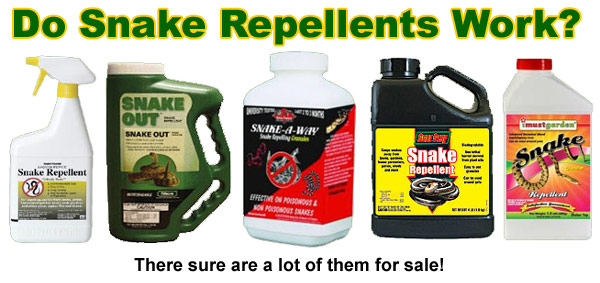
Who do you call to get rid of a snake? The county and city animal services will not handle a snake problem for you. They only deal with dogs or cats. If you want help with a snake problem,
you can call one of our professional snake removal experts. We service 98% of the United States, with over 500 companies, providing snake removal services in all major US cities and most smaller towns. Call
for a free price quote: Click here to hire us for snake removal in your town - click your state and city on the map.
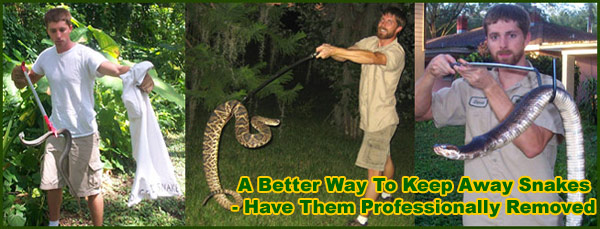
How to Get Rid of Snakes
Imagine walking through your backyard to your favorite sitting area only to be greeted by slithering snakes. Just the thought of a snake being in your presence can be enough to have you acting like a lunatic; however, don’t panic! Here’s a little comfort for you. Not all of them are poisonous. Of the 3000-4000 snakes in the world, only about 600 of them are actually poisonous and dangerous for humans to be near. However, that doesn’t mean that you have to be backyard buddies. So, how do you get rid of snakes?
Maintain Your Yard to Rid It of Snakes
If you’re not really the type to keep your yard maintained regularly, now’s the time to start. Snakes are attracted to those shrubs, bushes and thick foliage that may be surrounding your home because it gives them the perfect hiding and resting spot. Keep the grass cut low and shrubs neatly trimmed so that the moment you step foot in your backyard, you should be able to spot any wayward snakes. The same thing goes for your garden. Make sure that it is clear of leaves, debris, branches and any other trash that might make it easy for a snake to take up residence near your home.
Tall Grass Brings the Buffet
As you may already know, there are many homeowners who like the appearance of tall thick grass, especially in southern areas. However, this is a snake love potion. In fact, your tall grass will not only attract snakes but other rodents and insects as well. You might as well just give them all a backyard party because they won’t be going anywhere as long as the grass is high. If you have already noticed insects and other rodents in your yard or possibly in your home, you need to remove them completely. This will certainly give snakes the invitation to move in and enjoy the all night buffet.
Wood Keeps Me Cool
The thing about snakes is that although they like to find places that allow them to be unnoticeable, they also like to reside in cool places. This is why storing wood in your yard for the preparation of a long winter is a bad idea. Wood and compost makes the snakes come a slithering. Find another place to store your wood to keep the snakes from moving in and taking over.
No Snakes Allowed
Once a snake gets into your backyard, the next thing he’ll be looking forward to is you inviting him in. You can also be confident that if you don’t invite then, they will find a way in. To keep them from getting on the inside of your home, you need to look for openings in your home and seal them all off. Look near windows, pipes and doors and anywhere else that a snake may be able to find its way through.
Snake Repellant Moves Snakes Out
There’s nothing wrong with using a little snake repellant to get rid of your uninvited visitor. When you use this all over your property, the smell is so strong due to the sulfur in it that the snakes will be happy to turn the other way. The only thing about using snake repellants is that they are more effective if used in the area where you think the snake is. It disperses quickly and the odor disappears fast, and sometimes they can contain harsh chemicals that will turn us a way as well. If you have small children or pets in the home, you can sprinkle down a repellant powder to keep them away that won’t be harmful to your family.
I Caught You
Snake traps are also effective in getting rid of snakes. However, they are more effective when used in an area where a snake has already been spotted. The trap will emit a live mice odor that will attract the snake to it. Once the snakes leap at the bait, it then becomes trapped in a trap. These traps come in many different sizes to fit your needs.
While sometimes we may want to be the hero, handling a snake on your own is never a good idea. You never know which ones are poisonous which puts you at risk being hurt. Not to mention, depending on how big the snake is, it could get wrapped around parts of your body including your neck and set about strangling you.
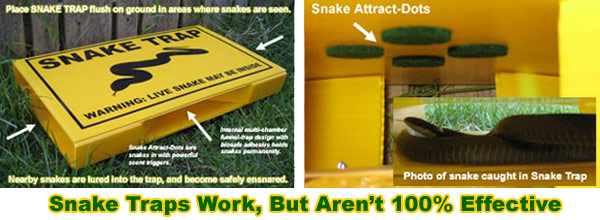
How to get rid of a snake out of your house, garage, or shed
It will be both harder and easier to handle a snake in a building, such as your house. In a house, the snake is confined. Thus, if it's safe to handle, you can pick it up. Or you can sweep it out with a broom. Same goes
for a garage. In a building, the chances of a snake trap working are very high, because the snake is confined to a small area, and will go to the trap. It will be difficult sometimes with a shed, because sheds are often built without a traditional floor, leaving opening to the outside all around the edge.
Sheds also have lots of items that are infrequently used, offering a snake a lot of places to hide. The good thing about a snake in the shed is that it’s not a snake in your house. The animal can be left in there without
worry that you or your family member will need to enter the room often. If you want to see if the snake will go away on its own, assuming there are openings to the outside, wait two or three days. Many snakes are transient
and will move on after a given amount of time. If you want the snake gone and do not simply want it out of the shed, seal off the opening from the outside, trapping the creature in the building. A snake glue trap can
then be put in the shed. One of the most recommended glue traps has scent lures inside, but it still might take a few days for the serpent to be captured. If the snake is venomous, the snake trap can still work; however,
you need to weigh the risk of entering the room to place the trap versus the benefit of just calling a professional to remove the snake. Remember that venomous snakes can strike longer than your arm can reach. Do not try
to kill the animal or remove it in person.
Here are some other snake links:
How To Trap Snakes
How to Kill Snakes
Snakes in the Attic
Does the City Or County Animal Services Department Help With Snake Issues?
One of the biggest misconceptions that many people will have about their local city and county animal services departments is that they will be able to help people with animal problems inside their own homes. The reality is that those who do go to such departments will usually find themselves disappointed with the results that they get. Animal services teams will often be stretched or have a limited resource available, and the priorities for these resources will be directed away from helping individuals that have animal infestations in their homes.
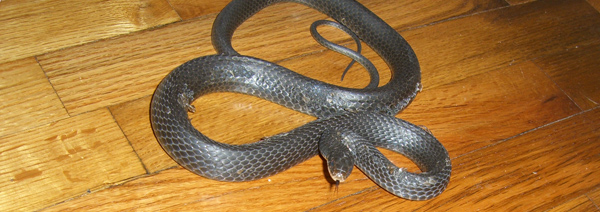
What Can The City Or County Animal Services Departments Do?
Although they may not be able to provide you with a professional to come in and remove the snakes for you, they will often be able to recommend a suitable individual who will be able to help you carry out the work. Because of their experience, they will also be familiar with the laws and regulations about animal removal, so they should be able to tell you what you can and can't do in terms of trapping and removing snakes.
Why Will They Not Remove The Snake?
The primary purpose of the city and county animal services departments will be to deal with any animals that are causing problems for the general population, such as stray dogs. They will also help to keep public areas such as schools, public buildings and parks clear of pest animals and other nuisances that animals can cause. However, these departments will only really deal with an animal problem if it is causing a hazard to the general public, so helping with problems in domestic properties is not within their remit.
Finding A Professional To Solve Your Snake Problem
While some city and county animal services departments will be able to provide a recommendation as to where you can find a suitable professional, it is actually easy to find a snake removal expert. There are plenty of local telephone directories and listings that will be able to help you find a good professional, while you will also find online directories that list experienced animal removal experts who can help resolve the snake issue. Make sure that you are asking the right questions, and ensure that the person you are dealing with is experienced, and has dealt with snake infestations regularly in the past.
Go back to the Snake Removal page.
What Equipment is Best for Trapping Snakes?
Catching a snake so that it can be removed is something that is fairly straightforward if you are dealing with a small non-venomous snake, but for larger snakes or those that are venomous, you will need to be a lot more careful. Indeed, if you do not have any experience in handling wildlife at all, if you are at all in doubt about whether or not the snake is venomous, then it is best to call a professional. However, if you are confident that you want to catch the snake yourself, then this list of equipment will help you to deal with the problem effectively.
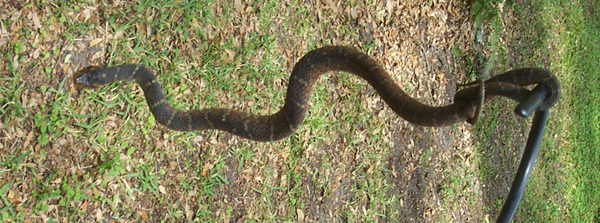
- 1. Protective Clothing
- 2. Snake Traps
- 3. A Pillowcase
- 4. Snake Pole Or A Stick
Dealing with any pest animal is something you should only do with precautions, and as even smaller snakes can deliver a bite, it is always worth wearing clothing to protect you. The hands are often the area that snakes will attack, so thick gardening gloves are a good idea, and preferably something with a sturdy material to prevent the snake's fangs from getting through, while thick long sleeved clothing is also a good idea.
There are several different types of snake trap available, but the most common type is the adhesive trap, which will usually have a scent bait inside, while the adhesive holds the snake in the trap to allow you to relocate it. Once you have taken the snake to a safe relocation spot, you can pour vegetable oil over the adhesive pad which will then release the snake and allow it to go on its way.
If you are dealing with a smaller snake or one that you are confident is non-venomous or cannot deliver a nasty bite, then a pillowcase is an ideal item in which to place the snake so that it can be transported for a short distance. This is also useful if you have to move a number of baby snakes if you have found them newly hatched in an area near your property.
Best Ways To Get Rid of Snakes
Non-venomous snakes are quite useful to have around the neighborhood as they will help in the elimination of other common pests such as insects, rodents and crickets, which constitute a food source for the snake. Having them in your yard however, is another matter entirely! The risk of being bitten by a surprised snake or snakes eating farm animals and eggs, far outweighs the snake’s usefulness in most homeowners’ books.
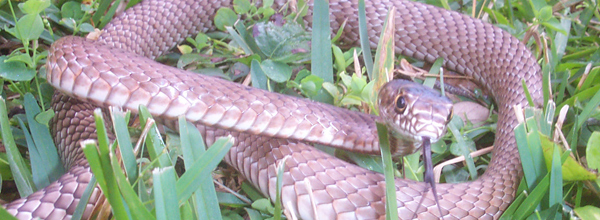
Firstly, an isolated snake sighting may not be cause for alarm. They are quite common in temperate regions and may just be passing through. In this case, you should leave them alone. By all means, be on the lookout in case they make another appearance in your yard, then you may want to decide on the best way to get rid of them.
If you are unsure as to whether the snake is venomous or not; or you’re simply uncomfortable handling a snake by yourself, do not hesitate to call a wildlife professional to do the job. If you do decide to handle it yourself, here are your options:
Carry out an exclusion exercise – modify your fences and seal up your house to shut snakes out. Be sure there are no snakes inside before you do this. Also identify features that may attract snakes in your yard, like shrubbery, debris, and food supply (insects, rodents). As long as there is a food source for them, snakes will be attracted to your space.
- Install snake-proof fencing. To construct one, you will need a fine wire mesh that is 2 to 3 feet high.
- Keep your environment clean. All habitats that allow for the breeding of common pests must be thoroughly wiped out; compost piles and garbage bins are good examples. No pests, no snakes!
- Remove all shrubbery and keep your lawn trimmed. This way, snakes have no hiding places in your yard.
- Eliminate debris (wood piles, rocks, bricks) on your property.
- Control of rodents like rats and mice also results in greater elimination.
Catch them with traps – traps are quite effective in catching the unpleasant reptiles in the house or yard. Live snake traps feature powerful scent dots that lure the snake to enter the trap, after which it is unable to move or strike. The trapped snake can thereafter be relocated and released back into the wild, far away from your neighborhood. Lethal traps also exist and they come with a snake-kill design. These cannot be re-used. Considering that snakes play such an important role in balancing the ecosystem, it is best to use live traps and simply relocate the reptile. Usage instructions are usually included in snake traps and must be adhered to. Great places to place your traps include shady spots, drop ceilings, basements, and along walls.
Use repellents – mostly composed of naphthalene, ammonia, or predator urine. The most effective predator-based repellents are mongoose urine or kingsnake musk. Most of the repellent solutions on the market are sadly, simply a waste of money as they rarely work; and when they do work, it is only for a short period. Some even end up poisoning the environment, like mothballs. Repellents must also be used with caution, especially where children and pets abound. Some others promise ultrasonic sounds that can only be heard by the pest, or vibrations; these have been proven to be bogus, so don’t bother with them.
If you find a snake inside a room in your house, shut it in there by closing the door, and stuffing a towel under the door so it does not escape. Then call your local wildlife department to have it removed. In the alternative, you may open the door if it leads outside so the snake can exit peacefully.
In all, it is a good idea to call in a professional when dealing with snakes. Snakes mostly bite when they are being attacked or handled without skill. Sometimes, getting rid of a snake can be as simple as spraying the snake with water from a hose or using a pool skimmer to pluck the snake out of the grass, and at other times, you require a lot of skill and tact. This is especially so when you do not know if the snake is venomous or not.
It is certainly always better to simply release snakes where they cannot constitute a nuisance as against killing them.
Go back to the Snake Removal page.


















